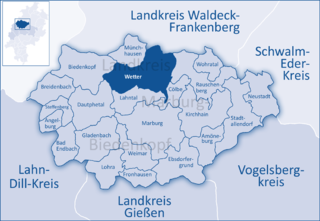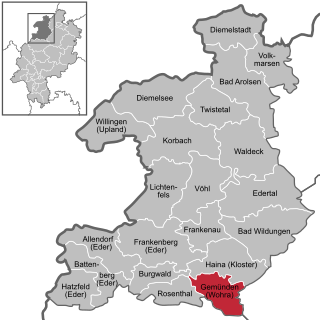Marburg-Biedenkopf is a Kreis (district) in the west of Hesse, Germany. Neighboring districts are Waldeck-Frankenberg, Schwalm-Eder, Vogelsbergkreis, Gießen, Lahn-Dill, Siegen-Wittgenstein.
Schwalm-Eder-Kreis is a Kreis (district) in the north of Hesse, Germany. Neighbouring districts are Kassel, Werra-Meißner, Hersfeld-Rotenburg, Vogelsberg, Marburg-Biedenkopf, and Waldeck-Frankenberg.
Waldeck-Frankenberg is a Kreis (district) in the north of Hesse, Germany. Neighbouring districts are Höxter, Kassel, Schwalm-Eder, Marburg-Biedenkopf, Siegen-Wittgenstein, Hochsauerland.

Wetter (Hessen) is a small town in Hesse, Germany. The rather unusual designation Wetter (Hessen-Nassau) stems from a time when the town belonged to the Prussian province of the same name, and nowadays is only used by the railway – even today, the railway station in town bears this name.

The community of Lahntal is found in the Marburg-Biedenkopf district in northwest Middle Hesse, Germany.

Amöneburg is a town in the Marburg-Biedenkopf district in Hesse, Germany. It lies on a mountain and is built around the castle of the same name, Burg Amöneburg.

Ebsdorfergrund is a community consisting of eleven villages in the southeast of Marburg-Biedenkopf district in Hesse, Germany.

Kirchhain is a town in Marburg-Biedenkopf district in Hesse, Germany.

Stadtallendorf is a town in the county of Marburg-Biedenkopf, Hesse, Germany. It lies about 18 km east of Marburg. In 2010, the town hosted the 50th Hessentag state festival.

Lohra is a community in Marburg-Biedenkopf district in the administrative region of Gießen in Hesse, Germany.

Cölbe is a community in Marburg-Biedenkopf district in Hesse, Germany.

Wohratal is a community in Marburg-Biedenkopf district in Hessen, Germany.

Schwalmstadt is the largest town in the Schwalm-Eder district, in northern Hesse, Germany. It was established only in 1970 with the amalgamation of the towns of Treysa and Ziegenhain together with some outlying villages to form the town of Schwalmstadt.

Melsungen is a small climatic spa town in the Schwalm-Eder district in northern Hesse, Germany. In 1987, the town hosted the 27th Hessentag state festival.

Oberaula is a community in the Schwalm-Eder district in Hesse, Germany.

Homberg (Ohm) is a town in the Vogelsbergkreis in Hesse, Germany.

Kirtorf is a town in the northern Vogelsbergkreis in Hesse, Germany. Through the town runs the Deutsche Märchenstraße, or German Fairytale Road, a touristic route joining many of the places commonly associated with the Brothers Grimm's tales.

Bischoffen is a community in the Lahn-Dill-Kreis in Hesse, Germany.

Gemünden is a town in Waldeck-Frankenberg district in Hesse, Germany.

Rosenthal is a small town in southeast Waldeck-Frankenberg district in Hesse, Germany.






















